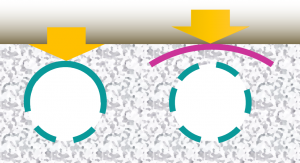Difference between revisions of "Pipes"
Jump to navigation
Jump to search
Jenny Hill (talk | contribs) m |
Jenny Hill (talk | contribs) m |
||
| Line 4: | Line 4: | ||
Pipes should have been manufactured in conformity with the latest standards by the Canadian Standards Association (CSA) or ASTM International. | Pipes should have been manufactured in conformity with the latest standards by the Canadian Standards Association (CSA) or ASTM International. | ||
*Perforated pipes should be continuously perforated, smooth interior HDPE (or equivalent material) with a minimum inside diameter of 100 mm. | *Perforated pipes should be continuously perforated, smooth interior HDPE (or equivalent material) with a minimum inside diameter of 100 mm. | ||
| + | **Wherever possible, pipes should be ≥ 200 mm internal diameter. | ||
**Smooth interior facilitates inspection and maintenance activities; internal corrugations can cause cameras or hydrojetting apparatus to become snagged. | **Smooth interior facilitates inspection and maintenance activities; internal corrugations can cause cameras or hydrojetting apparatus to become snagged. | ||
| − | + | ||
| − | |||
**A perforated pipe with many rectangular slots has better drainage characteristics than a pipe with similar open area provided by fewer circular holes <ref>Hazenberg, G., and U. S. Panu (1991), Theoretical analysis of flow rate into perforated drain tubes, Water Resour. Res., 27(7), 1411–1418, doi:10.1029/91WR00779.</ref>. | **A perforated pipe with many rectangular slots has better drainage characteristics than a pipe with similar open area provided by fewer circular holes <ref>Hazenberg, G., and U. S. Panu (1991), Theoretical analysis of flow rate into perforated drain tubes, Water Resour. Res., 27(7), 1411–1418, doi:10.1029/91WR00779.</ref>. | ||
*Non-perforated pipes should be used for conveyance to and away from the facility, including overflow. | *Non-perforated pipes should be used for conveyance to and away from the facility, including overflow. | ||
| + | |||
<gallery mode="packed" widths=200px heights=200px> | <gallery mode="packed" widths=200px heights=200px> | ||
Perforated Pipe 550x550.jpg|Pipe with slotted perforations | Perforated Pipe 550x550.jpg|Pipe with slotted perforations | ||
Revision as of 08:49, 14 March 2018
Perforated pipes are a common component of underdrains, infiltration trenches and exfiltration trenches.
Pipes should have been manufactured in conformity with the latest standards by the Canadian Standards Association (CSA) or ASTM International.
- Perforated pipes should be continuously perforated, smooth interior HDPE (or equivalent material) with a minimum inside diameter of 100 mm.
- Wherever possible, pipes should be ≥ 200 mm internal diameter.
- Smooth interior facilitates inspection and maintenance activities; internal corrugations can cause cameras or hydrojetting apparatus to become snagged.
- A perforated pipe with many rectangular slots has better drainage characteristics than a pipe with similar open area provided by fewer circular holes [1].
- Non-perforated pipes should be used for conveyance to and away from the facility, including overflow.
See also: flow through perforated pipe
- ↑ Hazenberg, G., and U. S. Panu (1991), Theoretical analysis of flow rate into perforated drain tubes, Water Resour. Res., 27(7), 1411–1418, doi:10.1029/91WR00779.


